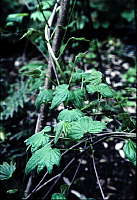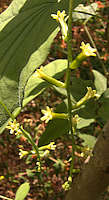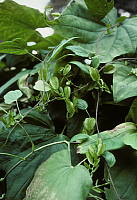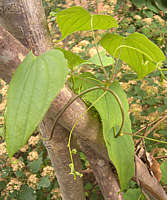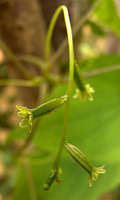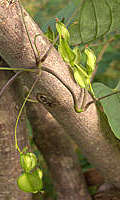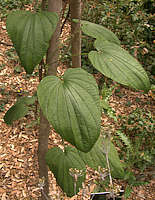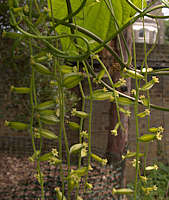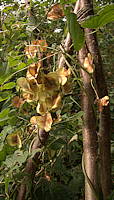|
The Dioscoreaceae is a group of 8 genera and over 600 species, including many interesting succulent caudiciforms and species with an underground tuberous root. Both caudexes and tubers store water and starchy food reserves to carry the plant through periods of dormancy. A climbing vine with heart shaped or lobed leaves, and without tendrils, is produced from the succulent tuber and may be a seasonal growth, or a more permanent one, depending on the species. Plants in this family are unusual among monocotyledons in having net-veined leaves. In some species e.g. Dioscorea bulbifera aerial tubers are produced from leaf axils along the vine. Tiny male and female flowers are produced on separate plants (dioecious). The fruit is a berry, capsule or samara, and the seeds are usually winged and flat.
This family includes the edible yams which were cultivated in Africa and Asia around 10,000 years ago and are important crops in tropical countries. The starchy succulent caudexes and tubers of many species of yam, especially African yams, contain toxins to discourage predators and require careful preparation before they can be eaten safely.
|
|
The species most commonly seen in collections of succulent plants is the "Elephant's Foot" Dioscorea elephantipes (was Testudinaria elephantipes). Tubers of wild yams, especially Dioscorea villosa and Dioscorea mexicana contain steroid precursors (Diosgenin) from which the constituents of the old progesterone birth control pill were synthesised.
A free-draining sandy soil rich in humus suits these plants. I like to put a layer of grit immediately under the caudices of Dioscorea elephantipes and Dioscorea sylvatica. I have never noticed any pests on my Dioscoreas, perhaps thanks to their content of bitter substances such as Diosgenin.
Dioscoreas and similar vining plants are best grown wound around a climbing frame. Buy a larger frame than appears necessary. It will soon be covered. Triangular frames as illustrated in the photograph of Dioscorea elephantipes tend to touch at their top, encouraging tendrils to explore and a row of plants to become hopelessly entangled. Pyrimidal frames made of black wire and suitable for a 12 in pot or larger help to confine the growth of vining plants to the footprint of the pot. Some careful weaving of the stems around the support is needed for a neat effect.
|
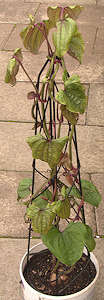 |
Dioscorea alata Linnaeus 1753 (Purple Yam, Winged Yam)
is the most widely distributed cultivated yam in Africa, SE Asia, Polynesia and W. Indies, although grown in smaller quantities than the African Yam D. cayenensis.
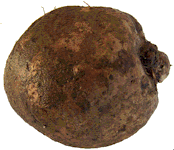 Because it develops and propagates itself via small bulbils formed in the leaf axils, Purple Yam has become an invasive species in some Southern USA states. The common name, winged yam refers to prominent ridges along the angular stem. The lumpy tubers have a purple-brown surface, but when cut the starchy core of some varieties has a violet tinge.
Because it develops and propagates itself via small bulbils formed in the leaf axils, Purple Yam has become an invasive species in some Southern USA states. The common name, winged yam refers to prominent ridges along the angular stem. The lumpy tubers have a purple-brown surface, but when cut the starchy core of some varieties has a violet tinge.
Considerable selection has occurred among the cultivated varieties. The wild yams are bitter and poisonous.
|
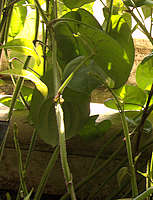 |
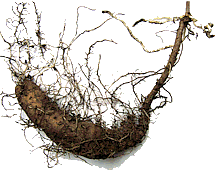
Dioscorea batatas Decaisne 1854 (Chinese Yam, Shan Yao) Syn. Dioscorea divaricata, Dioscorea opposita
A perennial vining plant with a large tuber. The small white flowers smell of cinnamon. Aerial tubers are produced along the stem and will propagate new plants. This species has the potential to become invasive.
Native to sunny hillsides of China and elsewhere in South-East Asia but thanks to its use as a crop has become naturalised elsewhere. Hardy to -18°C in a well drained soil. The tuber is edible and features in traditional medicine.
Dioscorea bulbifera Linnaeus 1753 (Air Potato)
produces aerial tubers from leaf axils along the 20 ft vine. The stem is rounded. The potato-sized bulbils are easy to harvest and more important than the tuberous roots. As every leaf has the potential to produce a bulbil, this plant has become a pest in warm climates such as Florida. However, it is a popular crop for small gardens. Native to tropical Africa and Asia and naturalised elsewhere in the tropics.
|
|
Dioscorea caucasica Lipsky 1892
This climbing plant has green stems bearing heart-shaped, prominently veined leaves with a matt-green surface. Stems, especially flower stems are slightly pubescent. The small yellow female ♀ flowers shown here are on the end of a prominent ovary destined to become a three-winged seed pod. Native to the Caucasus and the tubers are fully winter-hardy.
|
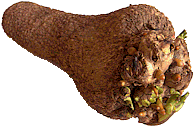
Dioscorea cayenensis Lamarck 1789 (Yellow Guinea Yam)
This widely-distributed plant from West Africa does not occur in the wild, probably being a selected cultivar or garden hybrid. The yellow flesh from the tuber is an important staple food in many countries with peelings fed to animals.
Dioscorea cayenensis subsp. rotunda (Poiret) J. Miège 1968 (White Guinea Yam)
Syn. D. rotunda Poiret 1813
is native to Africa and the most important cultivated edible species with over 200 cultivars. It is almost certainly of garden origin and probably related to D. cayenensis, although this is by no means certain. An edible yam purchased from a food store can certainly be sprouted, but in my experience requires a great deal of heat. The brittle angular green stems blacken quickly as the glasshouse cools in the autumn.
|

Above left: |
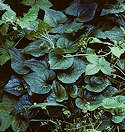
female ♀ flowers |
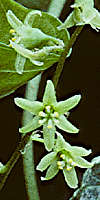
Above: |
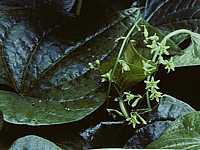
male ♂ flowers |
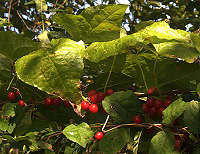 |
In England and Europe, the native wild yam (Black Bryony) is moderately common in ancient hedgerows and woodland margins. From a large underground tuber arises a seasonal twining vine (right) with characteristic glossy heart shaped leaves and small greenish-yellow flowers followed by bright red glossy berries. The berries often persist after the foliage has withered, making a fine Autumnal display.
While the leaves are similar to those of the African "Elephant's Foot," the smooth tuber can not be successfully grown on the surface for display. However, it grows well outdoors in a large pot or bedded out. Watch out for snails which can dig deep into a pot, eat into tubers and lay hundreds of eggs for another generation.
The plants are either male or female, so careful selection of cultivated plants is needed to obtain a display of the attractive glossy red berries. To grow the seeds, mascerate the berries in water and separate the seeds from the pulp to discourage moulds. After sowing the seeds, place the pot outside where it will be exposed to a winter's cold, after which the seeds germinate freely.
The tubers and berries are very poisonous, yet "Black Bryony" figured in traditional herbal medicine as a powerful diuretic. The result of an overdose was a painful death. External application of the mascerated tuber was safer and used to treat bruises, chillblains, gout and rheumatism.
Note: To confuse the unwary amateur herbalist, the native English "White Bryony" is a Cucurbit with different toxic and herbal properties. Both Black and White Bryony are sometimes found growing together in hedges and woodland margins. White Bryony was cultivated in the past as a counterfeit of Mandrake root, a continental tuberous plant from the Family Solanaceae with a long history of use as an anaesthetic and in childbirth. |
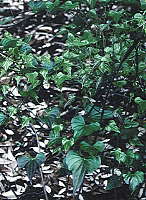 |
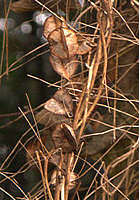 |
Dioscorea deltoidea Wallich ex Grisebach 1842
from Northern India is a seasonal vine with black stems bearing heart-shaped leaves with prominent veins. The inflorescence is a raceme of many, well-spaced tiny (one-eighth inch) green flowers. Seed capsules are dry, 3 winged pods. The tubers are fully hardy.
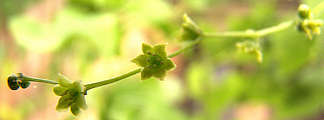 Above: male ♂ flowers |
Dioscorea dumetorum (Kunth) Pax 1887 (Bitter Yam)
is a popular crop in W. Africa as its cultivation requires little effort. Cultivars are less toxic than the wild forms which are sometimes used as poisons.
|
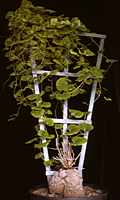
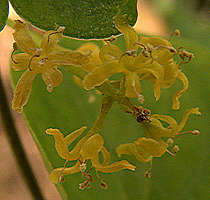
Above: male ♂ flowers |
Dioscorea elephantipes Engler 1908
Syn: Testudinaria elephantipes Burchell 1824 (Elephant's Foot)
This species is the most commonly seen Dioscorea in collections of succulent plants. The distinctive succulent caudex is covered with greyish-brown corky bark that becomes deeply fissured into polygonal segments with age.
In the late summer a seasonal growth of a twining black branching stem is extruded from the caudex and climbs and twines around any convenient support or other nearby plants. After a considerable length of stem has been produced very glossy heart shaped leaves develop on the numerous side branches. Considerable variation in the leaves may be seen between different cultivated plants.
Clusters of tiny yellow flowers are produced after the leaves but while the plant is still in leaf. D. elephantipes typically stays in leaf until the Spring and requires careful watering throughout the winter. It tolerates cool, frost-free conditions. I also like to dampen the dormant caudex periodically to stop it from drying out in hot weather and to remind it to break dormancy in late Summer. Feed with high nitrogen fertiliser to encourage growth of the caudex.
|
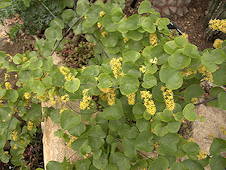 |
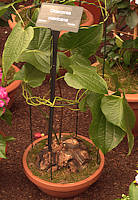
Display: Tynings Climbers |
Dioscorea mexicana Scheidweiler 1837 (Mexican yam, cabeza de negro)
Syn. Dioscorea macrostachya Bentham 1841
The large succulent caudex grows up to 3 ft in diameter and with maturity develops a series of polygonal protuberances separated by deep fissures. The caudex produces an annual vine up to 30ft long with large heart shaped leaves with strongly-marked venation. The inflorescence is a raceme of small greenish-purple flowers.
Native to a range from the Mexican state of Veracruz to Panama.
This yam contains Diosgenin and was used as the precursor in an early synthesis of progesterone. However, Dioscorea composita is now used as the starting material as it contains higher concentrations of Diosgenin. The tubers can be cooked and eaten.
|
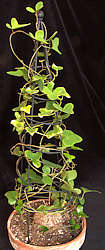 |
Dioscorea sylvatica Ecklon 1908
Name: Latin sylvatica = of the woods
from Uganda to Zimbabwe and the South African Cape Province, where it grows in forest margins. The plant produces a very large-lobed, flattened succulent caudex with smooth or cracked corky bark. It is not uncommon in collections of caudiciforms. The vining top growth can extend to 20ft and in the greenhouse needs to be constrained to a climbing frame. The foliage is more or less permanent and seems to grow at any time of the year. The matt green, heart-shaped leaves and stems die periodically and are renewed throughout the year. The inflorescence is a raceme of greenish-yellow flowers. Seed capsules are dry, 3 winged pods.
This undemanding plant should be fed with high nitrogen fertiliser to encourage the caudex to grow. A little water keeps it in growth during the winter, but if kept dry the leaves are deciduous. Cool, frost free conditions are sufficient. Plants are variable and several varieties have been described.
|
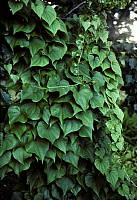 |
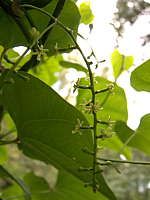 |
Dioscorea tokoro Makino 1889
Name: Japanese tokoro = edible root
has green stems bearing heart-shaped, prominently veined leaves with a matt dark-green surface. Small bulbils form in the leaf axils and can be used for propagation. Flowers are tiny, even by the standards of Dioscoreaceae.
This perennial vine is native to China and Japan. Although the vine is seasonal in this climate, the tubers are sufficiently hardy to be planted in the garden and survive the English Winter. The tubers are poisonous raw but are edible if soaked in lye and cooked. They are also used in traditional medicine.
Flowers shown here are female ♀ and are followed by winged seed pods.
|










